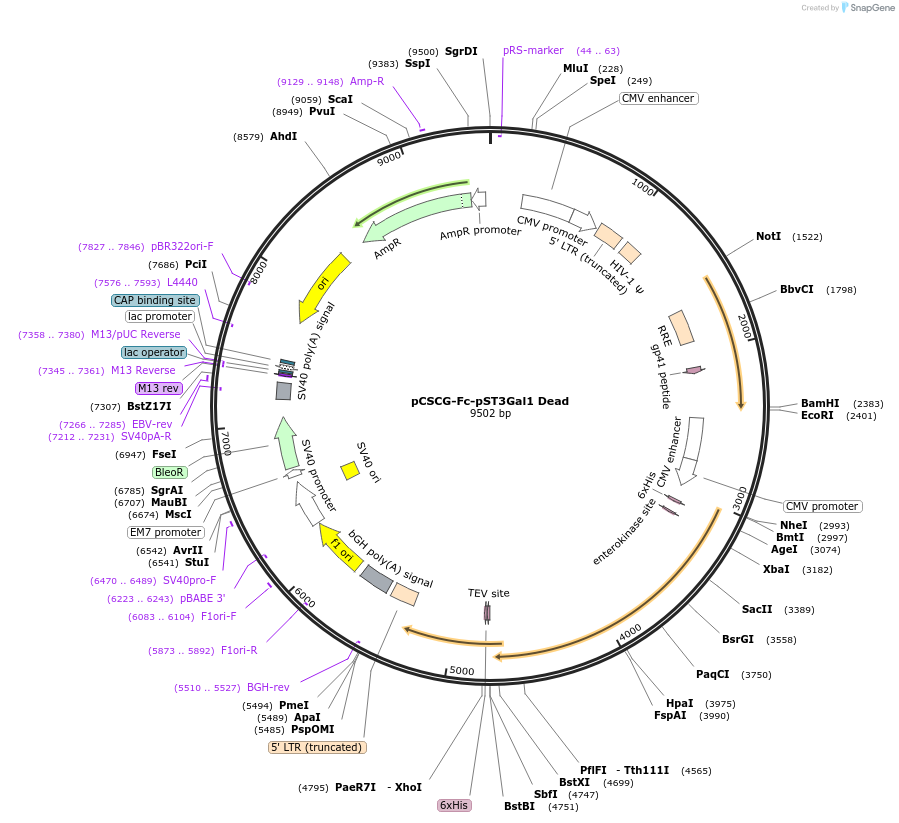pCSCG-Fc-pST3Gal1 Dead
(Plasmid
#228821)
-
PurposeExpresses Fc-fusion pST3Gal1 Dead (Q108A/Y233A/Y269F) in mammalian cells
-
Depositing Lab
-
Sequence Information
Ordering
| Item | Catalog # | Description | Quantity | Price (USD) | |
|---|---|---|---|---|---|
| Plasmid | 228821 | Standard format: Plasmid sent in bacteria as agar stab | 1 | $89 | |
Backbone
-
Vector backbonepCSCG
- Backbone size w/o insert (bp) 7772
- Total vector size (bp) 9503
-
Vector typeMammalian Expression, Lentiviral
Growth in Bacteria
-
Bacterial Resistance(s)Ampicillin, 100 μg/mL
-
Growth Temperature37°C
-
Growth Strain(s)NEB Stable
-
Copy numberHigh Copy
Gene/Insert
-
Gene/Insert nameFc-pST3Gal1 Dead
-
SpeciesH. sapiens (human); pig
-
Insert Size (bp)1731
-
Mutationamino acids 1-59 of pST3Gal1 were deleted and Q108A/Y233A/Y269F are introduced in pST3Gal1
- Promoter CMV
-
Tags
/ Fusion Proteins
- human IgG1 Fc region (N terminal on insert)
- 6His tag (N terminal on insert)
Cloning Information
- Cloning method Gibson Cloning
- 5′ sequencing primer CGCAAATGGGCGGTAGGCGTG
- 3′ sequencing primer CAGCATTGGTAGCTGCTGTA
- (Common Sequencing Primers)
Resource Information
-
A portion of this plasmid was derived from a plasmid made bySriram Neelamegham (Addgene #228819)
Terms and Licenses
-
Academic/Nonprofit Terms
-
Industry Terms
- Not Available to Industry
Trademarks:
- Zeocin® is an InvivoGen trademark.
Depositor Comments
Insert size includes N-terminal Fc portion.
Fc-pST3Gal1 Dead neither shows binding to glycosylated epitopes nor have enzymatic activity.
Please visit https://doi.org/10.21203/rs.3.rs-5004188/v1 for the preprint.
These plasmids were created by your colleagues. Please acknowledge the Principal Investigator, cite the article in which the plasmids were described, and include Addgene in the Materials and Methods of your future publications.
-
For your Materials & Methods section:
pCSCG-Fc-pST3Gal1 Dead was a gift from Sriram Neelamegham (Addgene plasmid # 228821 ; http://n2t.net/addgene:228821 ; RRID:Addgene_228821) -
For your References section:
Engineering glycosyltransferases into glycan binding proteins using a mammalian surface display platform. Hombu R, Beatty LE, Tomaszewski J, Park S, Neelamegham S. Nat Commun. 2025 Jul 18;16(1):6637. doi: 10.1038/s41467-025-62018-z. 10.1038/s41467-025-62018-z PubMed 40681527



